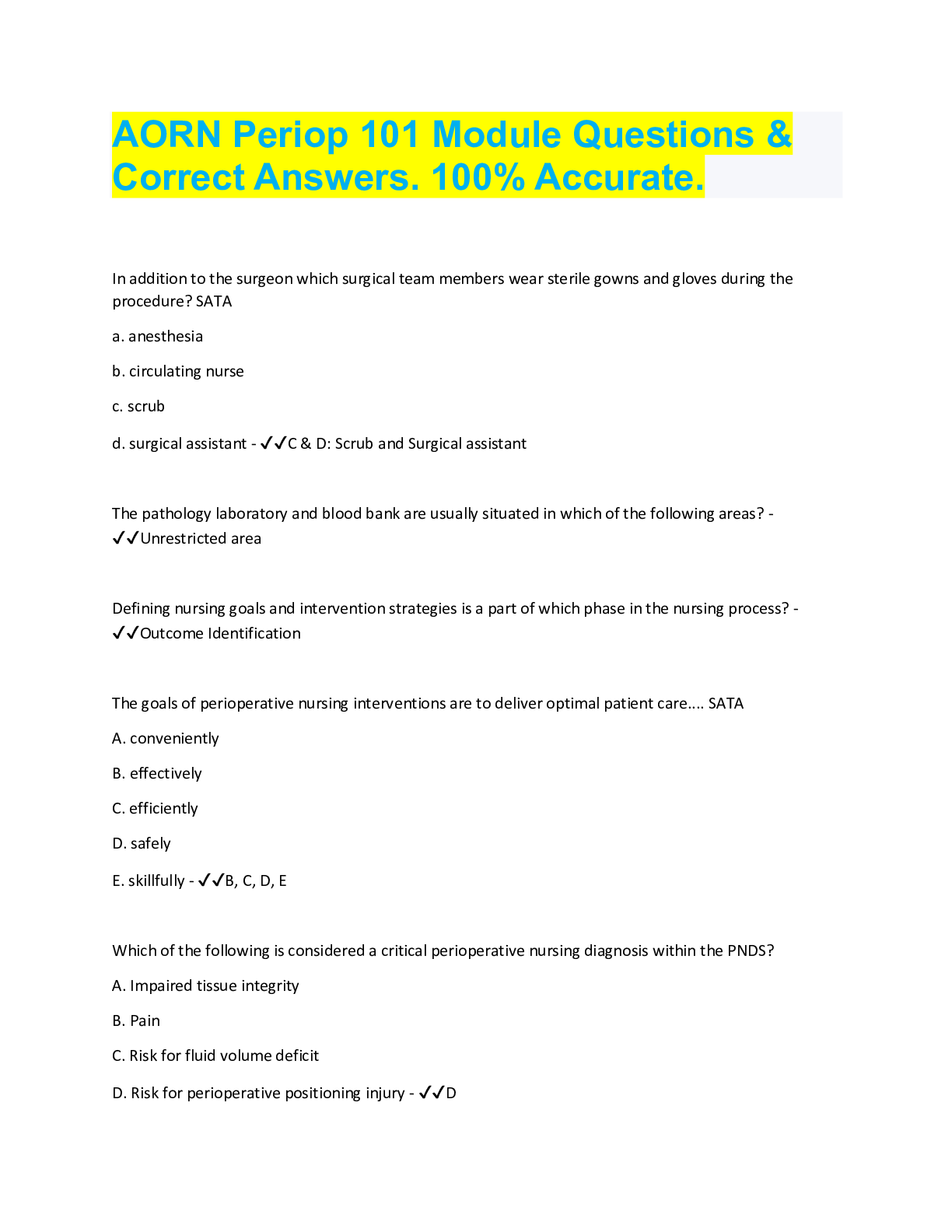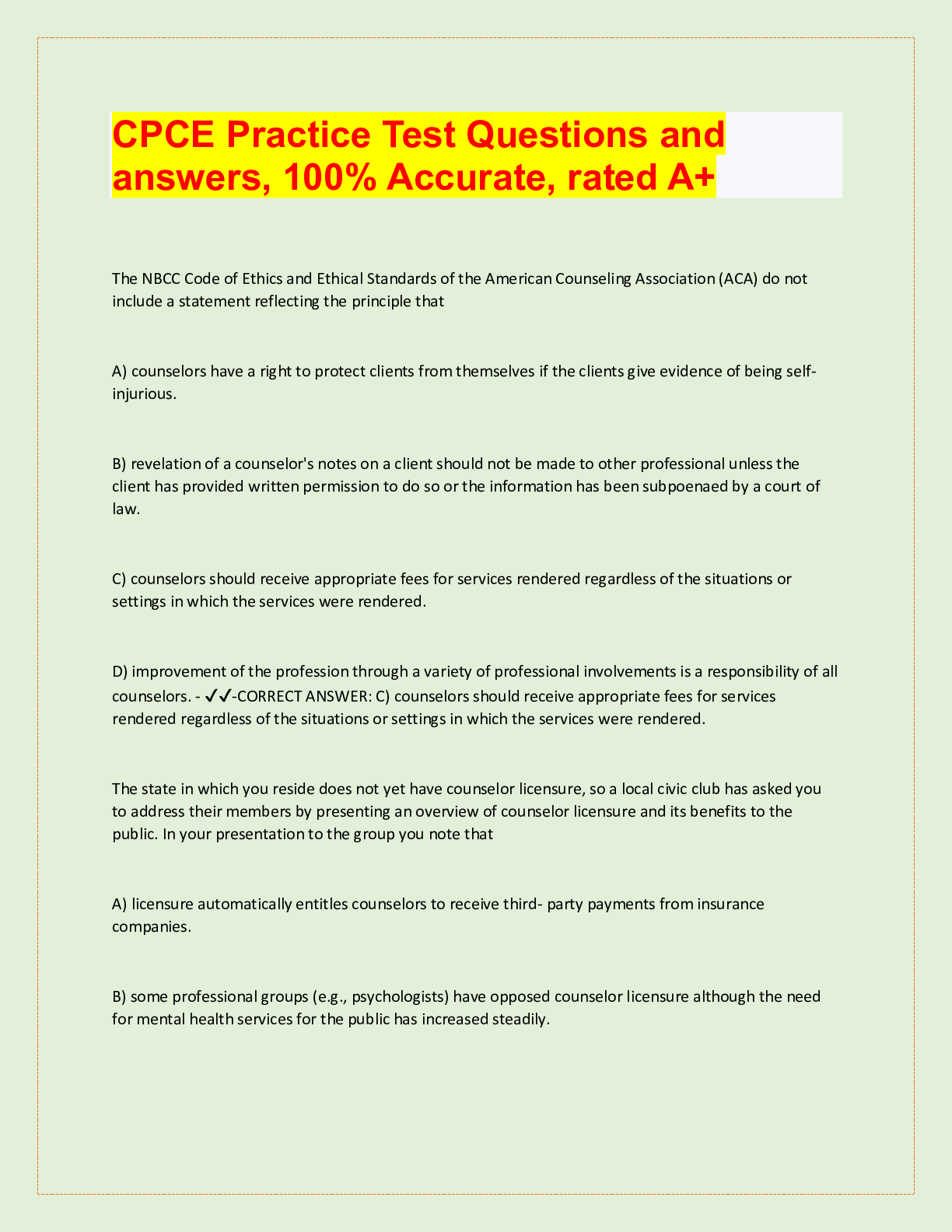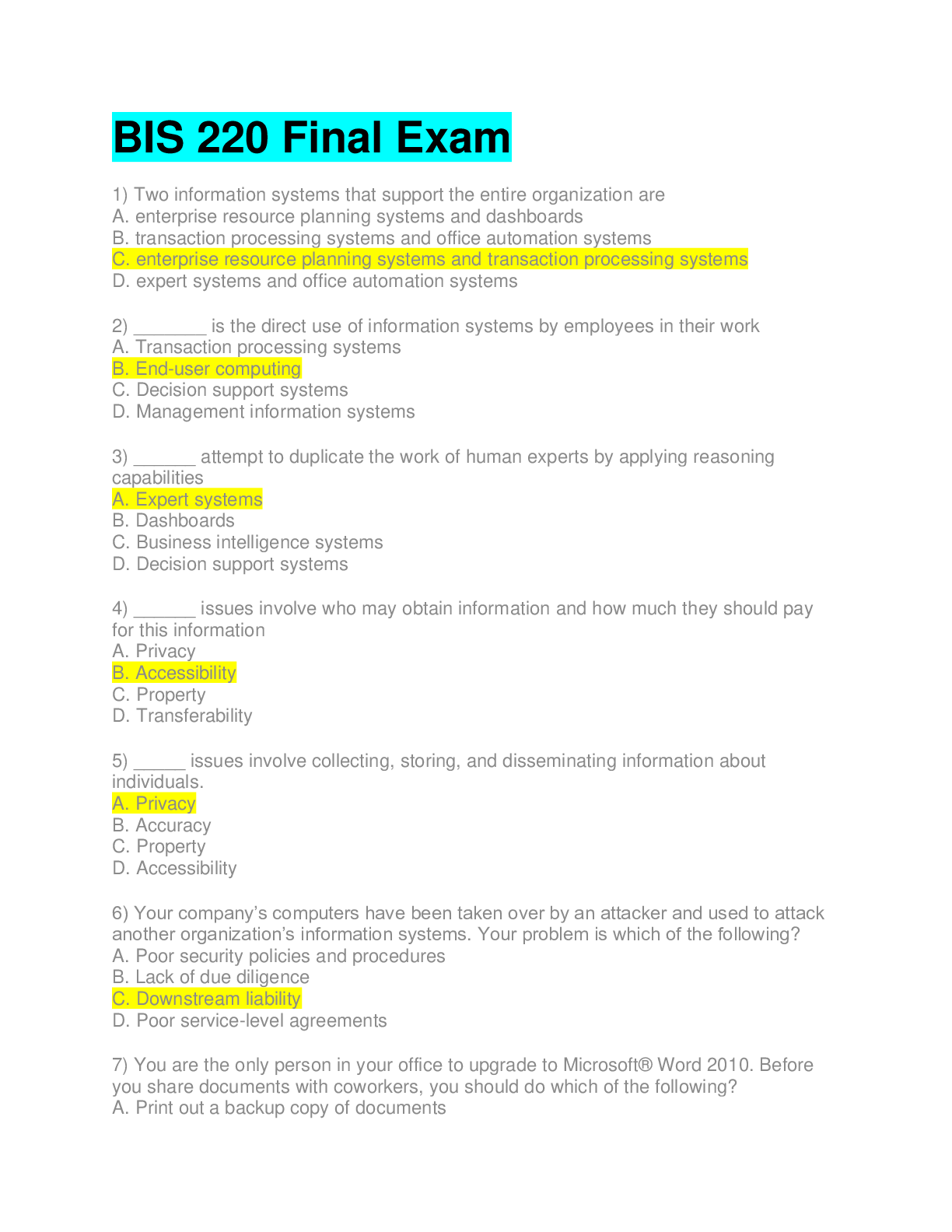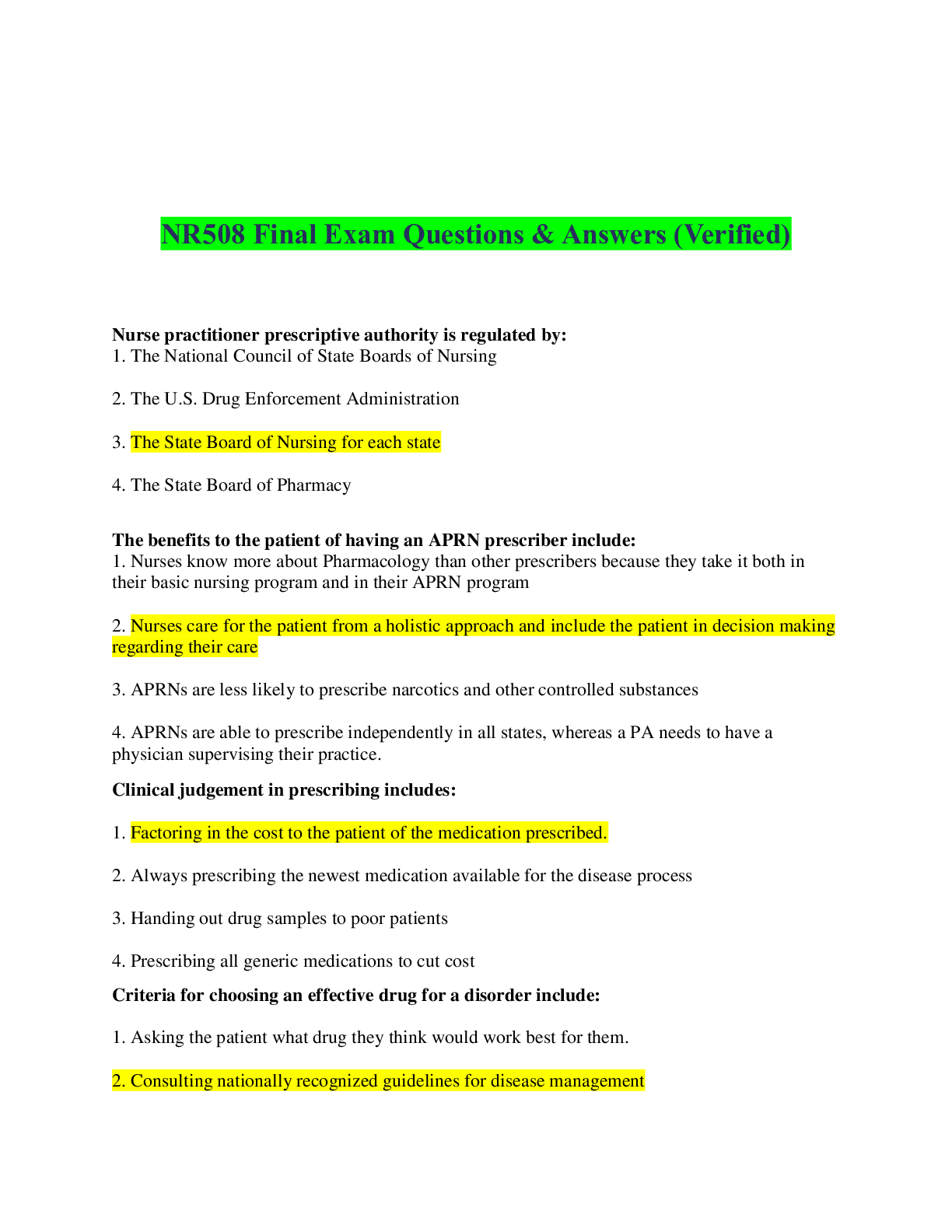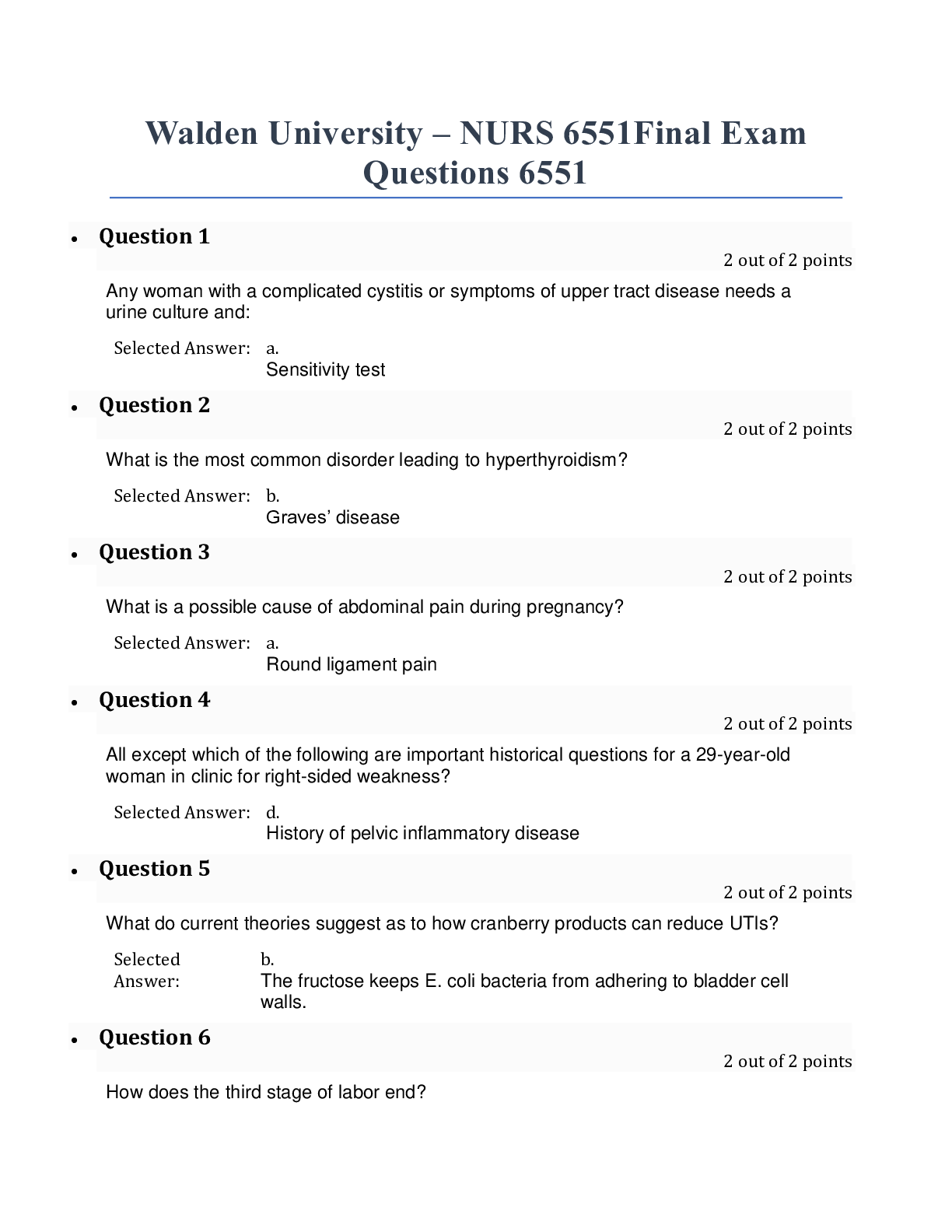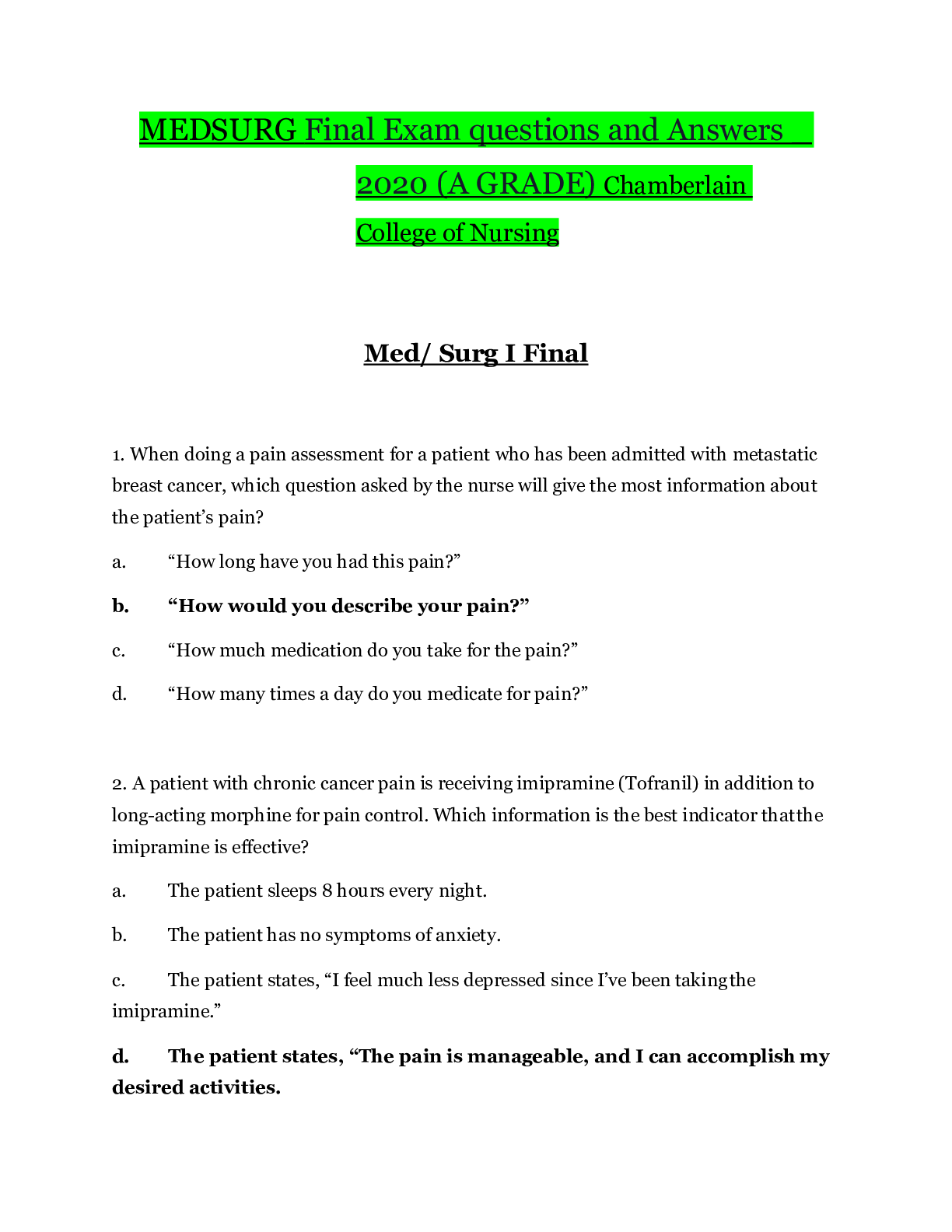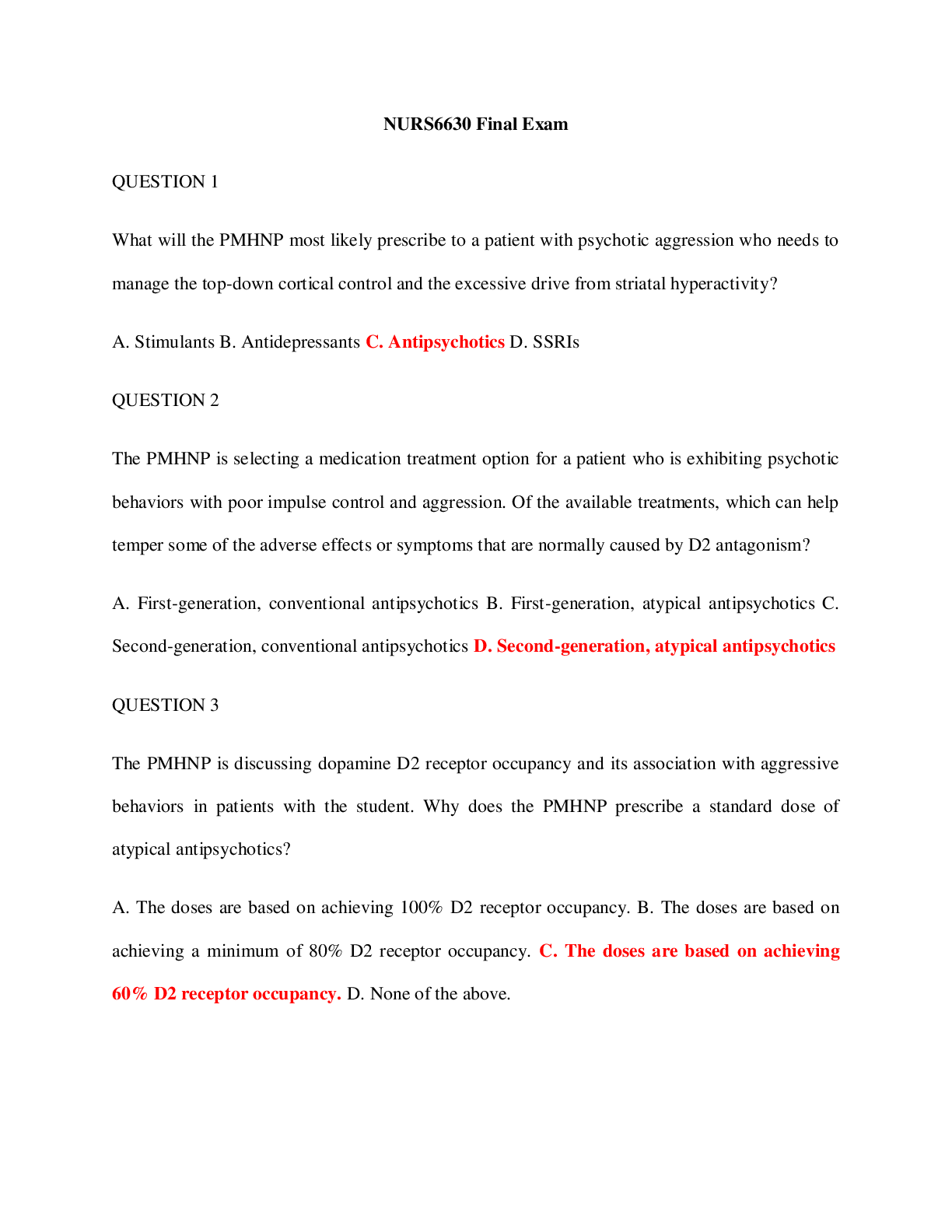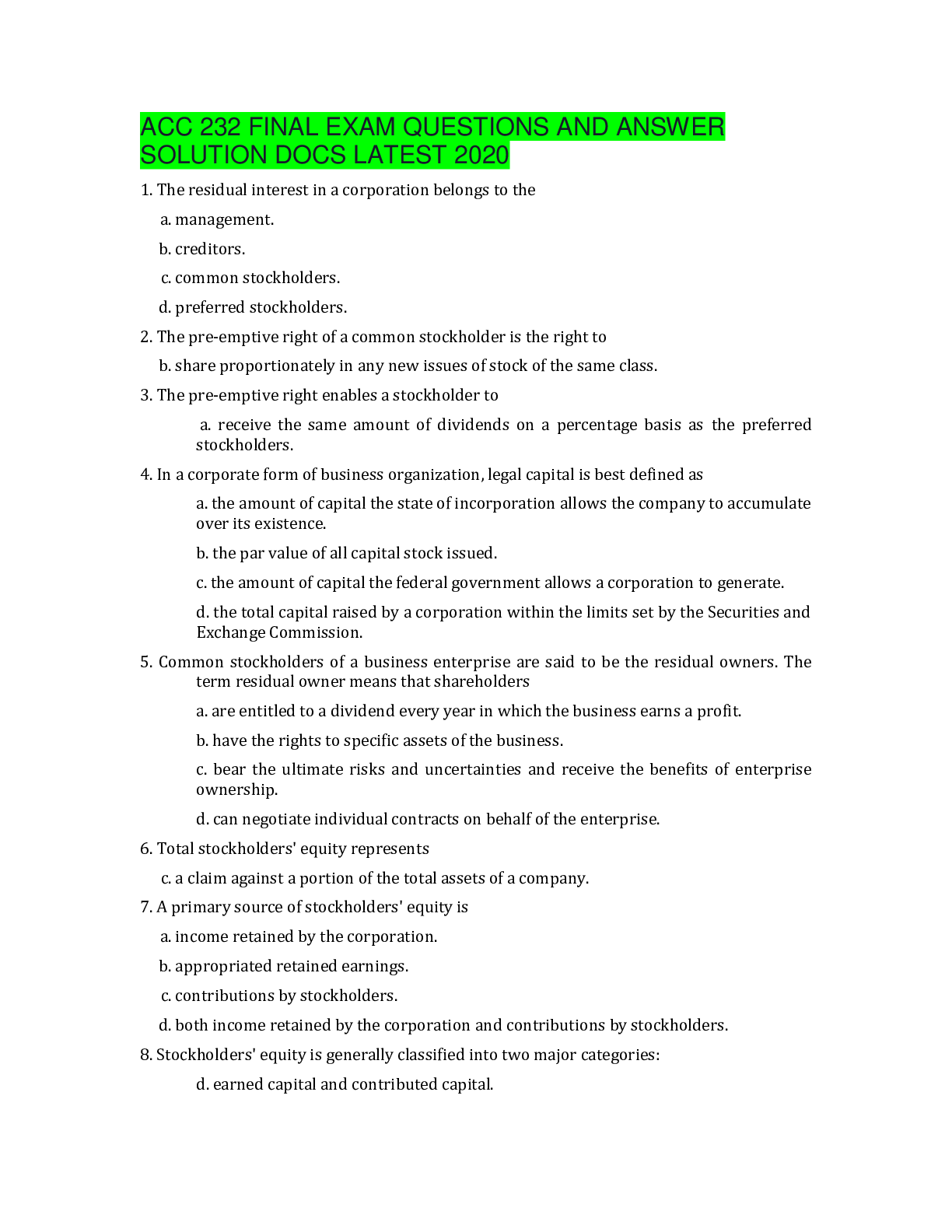BioChemistry > QUESTIONS & ANSWERS > WGU 785 Final Exam Questions & Answers, 100% Accurate, rated A+ (All)
WGU 785 Final Exam Questions & Answers, 100% Accurate, rated A+
Document Content and Description Below
WGU 785 Final Exam Questions & Answers, 100% Accurate, rated A+ Hemophilia Pedigree - Father has hemophilia, mother does not. What is the outcome for their kids? - ✔✔-His daughters would be c... arriers. This is x-link recessive. Autosomal: Dominant: - ✔✔-Autosomal: males and females equally affected. Dominant: non-carrier parents polymerase chain reaction (PCR) - ✔✔-The process of copying DNA in the lab. Uses Template DNA, Nucleotides (dNTPS), DNA Polymerase, and DNA primers. 3 Steps of PCR - ✔✔-1. Denaturation: DNA is heated to 95C to separate it. 2. Annealing: reaction is cooled to 50C; primers stick to the DNA you want to copy and add DNA polymerase. 3. Elongation: reaction heated to 70C and DNA polymerase, adding nucleotides building a new DNA strand. Base Excision Repair (BER) - ✔✔-How you repair a mutation. BER is used to repair damage to a base caused by harmful molecules. You remove the base that is damaged and replace it. *BER removes a single nucleotide* DNA glycolsylase - sees damaged DNA and removes it. DNA polymerase-puts the right one back in while DNA ligase seals it. Mismatch repair (MMR) occurs during: - ✔✔-replication. DNA polymerase proofreads but sometimes a mismatch pair gets through. MMR removes a large section of the nucleotides from the new DNA and DNA polymerase tries again. (Ex: C-T instead of C-A) Mismatch Repair corrects what kind of DNA damage? - ✔✔-When a base is mismatched due to errors in replication. Such as G-T instead of G-C. DNA polymerase comes by and fixes it. What happens when DNA polymerase binds to DNA to make RNA? - ✔✔-TRANSCRIPTION! DNA polymerase takes the individual nucleotides and matches them to the parental sequences to ensure a correct pair. It must bind with RNA primer to work. What is needed for DNA replication? - ✔✔-DNA polymerase Nonsense Mutation - ✔✔-Change in 1 nucleotide produces a STOP codon Stop= nonsense because it is no more. Silent Mutation - ✔✔-Change in 1 nucleotide but codes for the same amino acid. Silent= the change doesn't change the name of the protein Missense Mutation - ✔✔-Change in 1 nucleotide leads to a code for a different amino acid. Missense = mistake was made. What happends during RNA splicing? - ✔✔-During RNA splicing introns are cut out, the remaining exons are joined together. 5'ATG AGT CTC TCT 3' Find the DNA template strand. - ✔✔-3'TAC TCA GAG AGA 5' The DNA template strand is complimentary. So start with the opposite number, then go L-R with the complimentary letter. 5'ATG AGT CTC TCT 3' What is the corresonding mRNA sequence? - ✔✔-5'AUG AGU CUC UCU 3' This sequence is the same as the coding strand except T changes to U because it is RNA. RNA doesn't have T. How would a mutation from CTC to ATC affect the protein sequence? (CTC/ATC - coding strand, AUC - mRNA strand) - ✔✔-This will make a missense mutation because it changes the name of the protein. (look at the chart provided.) missense = mistake DNA replication process - ✔✔-DNA ->Transcription -> RNA -> Translation -> Polypeptide Describe how you would find what ionized Alanine looks like. - ✔✔-This is an amino acid. Look for the "R" group. Alanine is a hydrophobic amino acid that has CH3. It is a weak interaction. An ionized acid will have a + or - charge. Describe what causes the misfolding of protein in Alzheimer's Disease. - ✔✔-Protein misfolding is caused by intracellular tangles and extracellular plaques (senile plaques) caused by abnormal protein aggregation. TAU is fibrous material inside cells where the connections are lost. This becomes defective and forms filaments in the neuron. Amyloid-Beta is a large precursor protein in the cell. Excess amyloid-beta creates senile plaques. This starts in the hippocampus and moves up. Describe the process of neurodegenerative protein aggregation. - ✔✔-Alzheimer's is the most common neurodegenerative disease. The formation of aggregated amyloid-beta fibers is another characterisitc of Alzheimer's. However, neurodegeneration and memory loss can be detected before amyloid fibers accumulate in the brain. What are the molecules that help denatured proteins with folding? - ✔✔-Molecular chaperones are protein helpers. They bind to the newly made polypeptide and enable proper folding. Proper protein folding is vital b/c proteins that do not fold properly can lead to a variety of diseases. Normally, the chaperones that help new proteins fold can also help misfolded proteins refold into the correct structure. Genetic mutations that substitute one amino acid for another can cause incorrect folding. What are the 4 levels of protein structure? - ✔✔-1. Primary-chain of amino acids. PEPTIDE bonds form a polypeptide chain. This is a covalent bond (very strong) and does not denature. 2. Secondary-alpha helix and beta sheet. HYDROGEN bonds that contain the carboxyl group and amino groups. Denatured by salt and pH change. 3. Tertiary-side chain interaction (R group). Changes are seen with high temp, salt, change in pH, and reducing agents. (ex: sickle cell, arthritis, hemophilia) 4. Quarternary-more than 1 polypeptide. Change seen with increased temp. (Ex: Hgb) Hydrogen bonds are formed from - ✔✔-2 polar amino acids. (Contains Oxygen and nitrogen-OH, NH, NH2. On exterior surface) What structure would be unaffected by complete denaturation of its multi-subunit? - ✔✔- PRIMARY. Peptide bonds are strong and covalent. The primary structure is located at the backbone and does not denature. What is the simplest way to denature a protein? - ✔✔-Heat it up. The tertiary structure is hydrophobic. The tertiary structure is a protein structure stabilized primarily by the hydrophobic effect. What is the secondary structure made up of? - ✔✔-Alpha helixes and beta sheets Describe what is meant by "induced fit" of a substrate and enzyme. - ✔✔-The substrate and active site are somewhat complementary prior to substrate binding. Many enzymes will adjust their active site conformation slightly as the substrate binds to improve the fit. When the molecule is recognized as the substrate, the enzyme will adjust to form itself around the substrate more tightly to facilitate the reaction it catalyzes. Describe the Substrate-enzyme complex. - ✔✔-Each substrate binds to an active site, producing an enzyme-substrate complex. The geometric and chemical complement between the enzyme and substrate depend on noncovalent forces. Describe how the substrate and enzyme react with each other. - ✔✔-Substrate- molecule that an enzyme will bind to preferentially to any other molecule. Each enzyme is specific for that substrate. It will not react with molecules that are not its substrate. Active site- serves as the binding platform on the enzyme for its specific substrate and acts as the site of the chemical reaction. Competitive vs Non-competitive Enzyme Inhibition - ✔✔-Competitive inhibitor-usually a molecule similar in structure to a substrate that can bind to an enz [Show More]
Last updated: 1 year ago
Preview 1 out of 27 pages
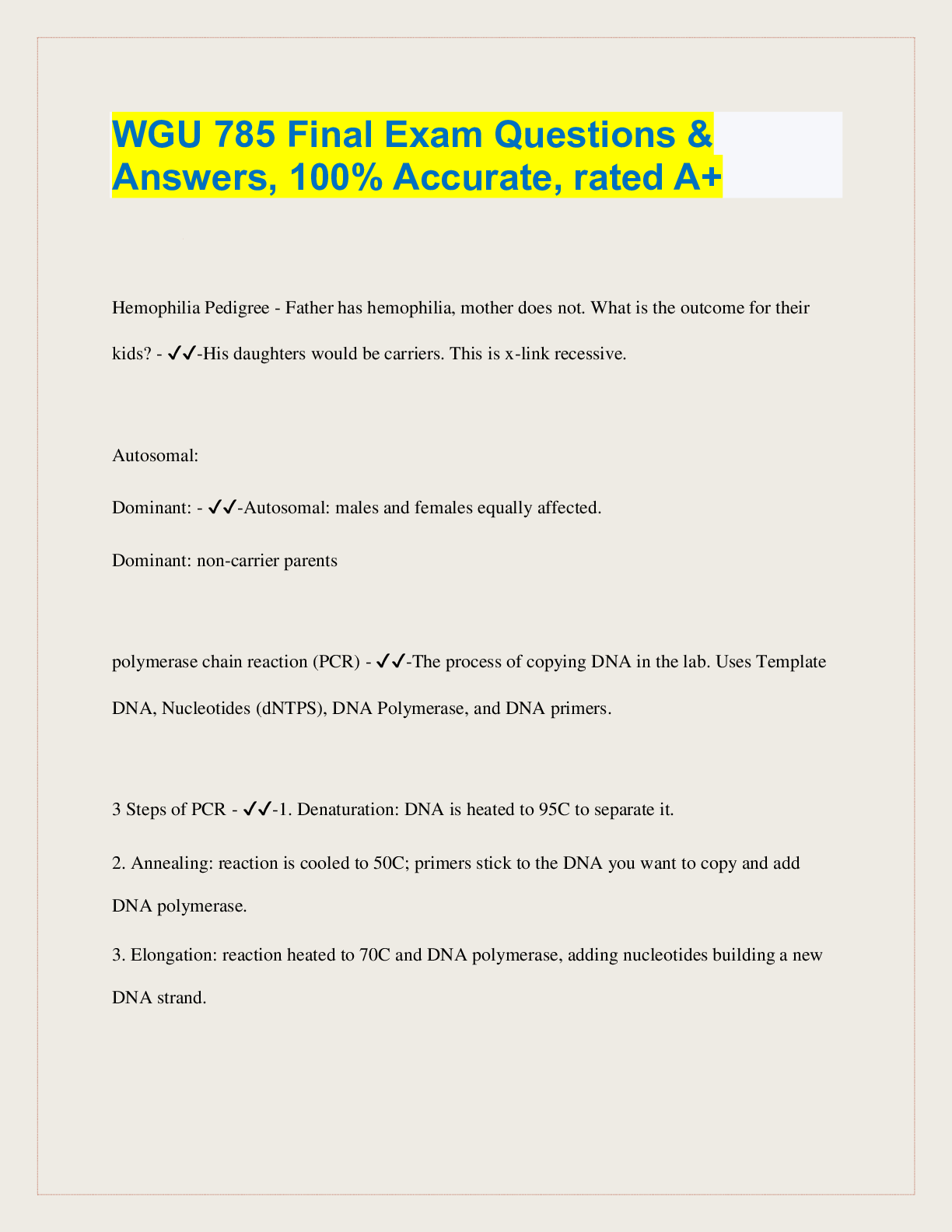
Buy this document to get the full access instantly
Instant Download Access after purchase
Add to cartInstant download
We Accept:

Reviews( 0 )
$12.00
Document information
Connected school, study & course
About the document
Uploaded On
Mar 10, 2023
Number of pages
27
Written in
Additional information
This document has been written for:
Uploaded
Mar 10, 2023
Downloads
0
Views
79






